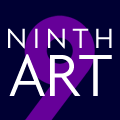>> Top Nine: O'Brien's Choice
>> Article 10: Arts From Their Elbows
More...

Let's talk about breasts. Great big huge ones. Always good for the hit rate, they are.
QUEEN & COUNTRY #9 this week devoted a page of its letters column to editor Jamie Rich responding to criticism of Leandro Fernandez, the artist working on the current story arc. It's hardly surprising that Fernandez' work divides the audience, since he's got a tendency to exaggerate and caricature all of his characters. It's a style that isn't going to appeal to everyone at the best of times, and makes a jarring break from the book's previous artists.
Much of the backlash, it seems, relates to Fernandez' rendition of lead character Tara Chase. Under previous artists, Chase was a fairly normal looking woman. Fernandez, in contrast, has drawn a stunning woman with absolutely ginormous tits.
Given that almost everybody else in the story emerges from his art style looking ugly as sin, it's a rather striking decision. As one printed letter comments, it doesn't look remotely like any previous version of the character and, without the aid of dialogue, wouldn't even be recognisable. That's a side issue, though.
There's more to the Tara Look 2002 than just breast size. Judging from Rich's editorial, he's received a fair amount of mail from people who rejected the very idea of Tara having quite such a... let's call it a Californian plastic surgery look. A bit loaded, I know, but I draw the line at calling her "beautiful" or "sexy" given that (a) those are both subjective terms, and (b) subjectively, the Fernandez version doesn't do a great deal for me.
After assuring everyone that this was not a sales-chasing decision (and I believe him absolutely), Rich says:
"One element of the flip-out that distresses me is the suggestion that Tara is somehow not the same character because now she is sexier, has bigger breasts, whatever. This seems to be a common problem in our society, and seems to rear its ugly head most often amongst those who consider themselves more intelligent... But really, where has it come from that someone who does conform to these mass media standards of what is beautiful must also be dumb? Why are women with large chests, skinny waits, or pretty faces automatically assumed to be idiots? How is Tara less capable?"
Well, up to a point, he's right. There's no correlation between natural breast size, facial bone structure and intelligence. But there's more to the Tara Look 2002 than just breast size. There's the wardrobe, the body language, the more general appearance.
[i1] Breast size per se doesn't tell you a great deal about the character, but dress sense and general style does, because those are character choices. Part of the skill of wardrobe design is to draw out character in that way, and readers are perfectly entitled to draw the conclusion that a character's personality is reflected in their clothes. Tara's wardrobe has been erratic over the last couple of issues - the suits are okay, but the see-through blouse for a field operation? The office gear which exposed a cleavage the size of Madagascar?
Is it in Tara's character to want to look like that? Decide for yourself on that one - but if not, I'd say that was a fair ground for criticism, irrespective of how you feel about women with large breasts. It would be going too far to say that Fernandez' design for the character codes her as stupid, ineffective or as a bimbo. But sure, it sends messages about the character, her self-image and her sense of style that don't quite square with previous versions.
Just because we're good little liberals (and you are, aren't you?) who don't make moral judgements over how a woman dresses doesn't mean we have to pretend that it doesn't reveal something about her personality. The way I dress certainly says something about mine. It says I hate shopping for clothes and end up buying bland crap - but it's still something. Everyone's clothes reveal something about them.
Having said that, it seems clear that there's more to the backlash than Fernandez' understanding of Tara's dress sense. As Rich says, there is an element here of some readers rejecting that look on general principle, not because of what it is but because of what it represents to them.
It sends messages about Tara that don't square with previous versions. An interesting thing about Fernandez' QUEEN & COUNTRY work is that Tara is the only female character whom he's exaggerated in quite this way (which also damages the argument that it's just part of his style). Granted, it's not a book that's exactly swimming in female cast members, but it does feature some minor intelligence agency staff members, and includes a fairly major role for the CIA contact character, Angela Cheng, all of whom have been drawn with normal proportions and clothes. So why just Tara?
Well, she's the protagonist. Maybe Fernandez is simply trying to idealise the hero. And as is so often the case, male heroes are exaggerated to make them more athletic while female characters are exaggerated in a way that stresses their sexuality. The commonly stressed elements do reflect a distinct male perspective on the world. This alone is enough to lose the interest of a fair number of readers who, for unavoidable biological reasons, do not share that perspective.
It also sounds alarm bells for other reasons, though. Like it or not, there are reasons why audiences have come to associate large-breasted, blonde women with lack of talent and bad products. An awful lot of them have gotten work in film and television despite not being terribly good at their jobs.
That reasoning doesn't translate to comics, but one element does. Filling your TV show with bimbos says something about the attitude of the production team to their work, and it isn't particularly flattering. Equally, comics readers are used to drawing inferences when they think creative teams are working along similar lines.
Oni tends to avoid the clichés that have given comics a bad reputation. Things have improved dramatically since the mid-nineties, when Previews was packed full of women in leather bikinis spreading their legs in poses that would have been seductive if they hadn't involved so many dislocated joints, but there are still plenty of them in there. You know the ones. ("For all you lovers of gun-totin', karate-kickin' cat-fightin' gals who battle terrorism!")
Comics have tended to hyper-sexualise their female characters in a way that sends an unmistakable message that those who create them and those who read them are all sad, lonely men who women cross the street to avoid. You don't need me to tell you this, because it's a ubiquitous complaint that this is precisely the sort of image that comics need to get away from.
This is why some people get so annoyed about the bad girl indie books despite the fact that they sell bugger all. They play into the hands of every negative stereotype about comics by proving them right. Comics readers hold the bad girl fanbase in contempt for exactly the same reason the general public disdains all comics fans.
The bad girl books are politically sensitive (within comics) beyond their meagre readership, and equally, certain readers can backlash viciously against anything that smacks of that ethos spreading into other comics. Oni, in particular, has a deserved reputation as a publisher that tends to steer clear of all the clichés that have brought comics the dismal reputation they have today.
[i2] Consequently, Oni attracts an audience that is particularly likely to backlash against this sort of artwork - not so much for what it is as for what that kind of character design has come to represent within comics and elsewhere. Tara's appearance sets off all those alarm bells, not least because it's so different from any previous rendition of the character that it clearly has to be a conscious decision of some sort on the artist's part.
But back to the key, hit rate-boosting point: Tara Chase has got enormous great big tits right now. And for a large part of the audience, it doesn't work - because there's no way on earth that the character as established could or would look or stand like that; because it renders the character unrecognisable and plastic-looking (even within Fernandez' own style); but most of all because that look has come to be associated with all manner of things that QUEEN & COUNTRY's readers are predisposed to loathe.
Sometimes it doesn't really matter whether the audience is correct in reacting a particular way. The fact that that's how it reacts is sufficient on its own to determine whether something works.

This article is Ideological Freeware. The author grants permission for its reproduction and redistribution by private individuals on condition that the author and source of the article are clearly shown, no charge is made, and the whole article is reproduced intact, including this notice.

